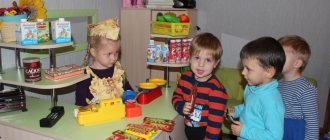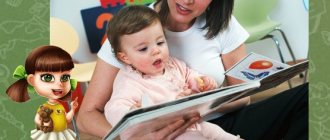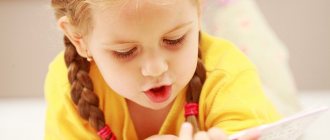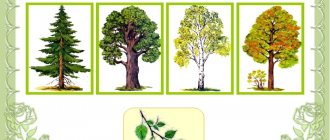Games and exercises for the formation of grammatical structure of speech in preschoolers
Card index of games and exercises for the formation of grammatical structure of speech in preschool children
2 Junior group
Contents: 1. A wonderful bag 2. A hint 3. What kind of dog is there? 4. Guess whose voice 5. “One is many” 1. WONDERFUL BAG Purpose: To focus on the gender of a noun when identifying an object by its characteristics. Equipment: Hare, carrot, cucumber, apple, tomato, bag. Progress of the game: Let's tell the children something like this: “A hare came to our kindergarten. Running bunny, what's in your bag? Can I have a look? What is this? (Carrot.) What carrot? (Long, red.) Put the carrots on the table. And what's that? (Cucumber.) What cucumber? (In the same way we take out a tomato, an apple, etc.) Now the hare wants to play with you. He hid all the vegetables and fruits in a bag. The bunny will put his paw into the bag, take a vegetable or fruit and tell you about it, and you must guess what the bunny has in his paw. Listen carefully. It is long and red. What is this? (Carrot.) It is green and long. What is this? (Cucumber.) It is round and red. What is this? (Apple.) It is round and red. What is this? (Tomato.)" If the children answer the last two questions incorrectly, we repeat, emphasizing the pronoun with our voice: "Listen again. It is round and red. It's round and red. Now find and put vegetables in the bag. What's left? (Apple.) Apples are fruits. Thank you, hare, for coming to us. Goodbye". 2. Prediction The game helps teach a child to finish a word and develops visual-figurative thinking. How to play: say with your child: Ko-ko-ko - the milk has run down on the stove... (ko). Sha-sha-sha - green gro... (sha). Chu-chu-well - pedal turn... (chu). Switch roles. The child says the syllables, you finish the word. For example, a child says: “Lo-,” - you finish: “-shad.” We fix it: we continue to play: puddle, chairs, window, car. If the child copes, invite him to add several endings to one syllable: no-zhnitsi, -gi, -ski. Whoever selects the most syllables wins. 3. What kind of dog is there? Goal:
Development of correct, competent speech, logical thinking.
You can ask the child to imagine a dog and tell him as much as possible about it: what kind of fur it has, what it likes to eat, what shape its tail and ears are, what its character is, etc. Children say the sentences one by one. Other topics: “What is spring like?”, “What is a cow like?” and so on. 4. Guess whose voice Goal
: To develop auditory attention in children, teach them to clearly pronounce polysyllabic words loudly and in a whisper, distinguish between words that sound similar, correctly place emphasis
Progress of the game:
Educator, imitating the voices of animals, i.e., pronouncing various sound combinations , invites children to guess who screams like that.
When the children guess and correctly name the animal, he asks them to determine whether the animal is large or small. For example, the teacher loudly says kva-kva-kva and asks: “Who is this?” Children: "Frog." Then the adult pronounces the same sound combination quietly. “Who is this?” he asks. Children: “This is a frog.” - “How did you know that this was a frog?” Children: “The little frog croaks quietly, and the frog croaks loudly.” The teacher ensures that all children listen carefully and answer questions correctly. 5. “One - many” PURPOSE: To train children in the formation of the plural of nouns in the nominative and genitive cases.
Teach the ability to listen to a peer and respond in a timely manner when it comes to the same subjects (middle, senior groups). GAME MATERIAL: paired pictures with images of toys, on one of which one object is drawn, and on the other - several of the same objects: balls, tumblers, pyramids, horses, trucks, bunnies. Progress of the game: first, the teacher lays out subject pictures depicting one object. The child makes up a simple sentence: “One duck”... etc. Then the teacher lays out pictures showing many objects. The child makes up a sentence: “A lot of ducks,” etc.. Middle group
Contents: 1. Game “Scrabble.” 2. Game exercise “Suggest actions.” 3Game “Who can name the most actions?” 4. Exercise “Name the first sound of the word” 5. “Make up a story” 1. Game “Scrabble”. Goal:
to consolidate the body parts of animals, and the formation of genitive case forms with the preposition U. Visual material: subject pictures.
Progress of the game
: children were given pictures of animals and asked questions.
Speech material: - Who has a big trunk? - Who has a fluffy tail? -Who has a pointed nose? - Who has long ears? - Who has hooves? 2. Game exercise “Suggest actions.” Game games and exercises to develop skills in the formation of prefixed verbs Goal:
to teach children to form and correctly use the verb GO with different prefixes.
Visual material: toy car. Progress of the game
: the experimenter showed actions with the machine and began sentences, and the children had to continue the sentences and name the action.
Speech material: - The car left the house (what did it do?) ... (DRIVEN AWAY); - The car is on the road...(It went); - The car is approaching the bridge... (DRIVED UP); - The car is on the bridge... (Drived); - The car drove off the bridge... (drove); - The car is a tree...(drove around). The experimenter repeated verbs pronounced correctly by the children, emphasizing the prefixes with his voice. 3. Game “Who can name the most actions.” Goal
: actively use verbs in speech, forming various verb forms.
Equipment: pictures: items of clothing, airplane, pen, sun, dog, bee, snowflake. Progress of the game:
The Incompetent comes and brings pictures.
The children's task is to choose words that denote actions related to objects or phenomena depicted in the pictures. For example, what can you say about an airplane? (it flies, buzzes, rises); what can you do with clothes? (wash, iron, sew up); what can we say about the sun? (warms, shines, rises); what can you do with the doll? (play, dress, put on shoes), etc. 4. Exercise “Name the first sound of the word” Educator. I have different pictures, let's name them (points to the pictures, the children take turns naming them). I'll tell you a secret: a word has a first sound with which it begins. Listen to how I name the object and highlight the first sound in the word: “Drum” - “b”; “Doll” - “k”; “Guitar” - “g”. Children take turns being called to the board, naming the object, emphasizing the first sound, and then the sound in isolation. 5. “Make a story” Goal:
Learn to write short stories about people of different professions;
Progress of the game:
Children learn to write stories about professions. The teacher gives an example: “This is a doctor. He heals people. He prescribes different medications for each patient. The doctor looks at the throat, listens, takes the temperature, gives injections. Following the model, children make up short stories from the pictures about the profession of a salesman, hairdresser, pilot, etc.
Senior group
Contents: 1. Game “Say Otherwise” 2. Game “Settle in the House” 3. Game “On the contrary” 4. “Reporter” 5. “Unravel the words” 1. Game “Say Otherwise” Purpose:
to teach children to select synonyms.
It's a dull time - dull, sad, dreary, gloomy, sad. The sky is gray - dark, cold, cloudy. Trees are naked - naked, naked (without leaves). The flowers dried up, withered and withered. Food - food, food, food. Long - long, long, long. Etc. 2. Game “Settle in the House” The goal
is to develop the ability to determine the syllable structure of a word.
The teacher introduces the “guests” using a riddle or something else and offers to place each guest in a house. At the same time, he draws the children’s attention to the fact that one house has a window with one sash, and the second one has two. To determine which guest has which house, you need to determine how many syllables are in the guest's name. If there is one syllable, then we put the guest in a house with one door. If there are two syllables, then we put the guest in a house with two doors. To complicate the game, you can then invite guests to a housewarming party and distribute them according to the same principle. 3. Game “On the contrary” Games to enrich vocabulary Purpose :
- exercise in the selection of antonyms (words - enemies).
Move:
It’s your turn to play the game “On the contrary”.
I will say the word “high”, and you will answer... (“low”). I will say the word “far”, and you will answer... (“close”). I will say the word “ceiling”, and you will answer (“floor”). I’ll say the word “lost”, and you’ll say (“found”)! I’ll tell you the word “coward”, you will answer... (“brave”). Now I’ll say “the beginning” - well, answer, ... (“the end”). 4. “Reporter” The child is given a toy microphone and answers the journalist’s questions. The teacher also has a microphone in his hands. Plan of questions: What is this? (Headdress …). What parts does it consist of? What colour? What time of year are they worn? Who dresses? (men, women, children). 5. “Unravel the words” Goal
: learn to compose sentences using these words.
Progress of the game:
The words in the sentence are mixed up. Try to put them in their place. What will happen? Suggestions for the game: 1. Smoke, coming, pipes, from. 2. Loves, little bear, honey. 3. Standing, in a vase, flowers, in.
Preparatory group
Contents: 1. “Animals” 2. “Count it up” 3. Games for the formation of complex words. 4. “My—my—mine—my” 5. “Think and name it.” 1. “Animals” Games for the formation of new words using suffixes. Purpose of the game
: form new words using suffixes.
Progress of the game: Bunny - bunny - bunny - bunny - bunny - bunny. Wolf - wolf cub - she-wolf - wolf - wolf. “House – house – house – house” Purpose
: to practice the formation of nouns using the suffixes -ik, -ishk, -ishche;
in the use of formed nouns in R.p.; develop the ability to hear grammatically correct speech. Material:
card divided into 4 parts, each of which contains images of a house, a house, a house and a house;
small cards of different colors (yellow, blue, red) with images of animals, furniture, dishes and other items available in the house; colored squares (3 pieces of each color) Progress
: 3 cards of different colors with animals or dishes, furniture, clothes, etc. are laid out next to the picture of a house.
The child is asked to name the objects and determine whether they can be in the house, house and house, connecting the names of the objects with a certain suffix. First, children independently perform the action, laying out the results of their solution in colored squares corresponding in color to cards with objects and animals, next to the image of different houses, then they explain their actions and name the resulting words. For example: “A hare and a cat can live in a house, because you can form the words “bunny” and “cat.” But the fox will not be able to live there, because... The word 'fox' doesn't exist." 2. “Count it up” Games for agreeing nouns with numerals in gender, number and case. Goal
: learn to form the plural of a noun.
For example: Counting to 5 with the word fox. One fox, two foxes, three foxes, four foxes, five foxes. You can count hares, bears, hedgehogs, etc. 3. Games for the formation of complex words. Goal
: teach children to form complex words from two simple words.
How to play: The chicken has a short tail - it is short-tailed. The goose has a white head - it is white-headed. The hare has long ears - he is long-eared. The heron has long legs - it is long-legged. 4. “My—my—my—my” Purpose:
an exercise in agreeing a pronoun with a noun.
1. An adult calls the children words and asks them to answer the question “whose?” (“whose?”, “whose?”, “whose?”), correctly agree the pronoun with the noun. Approximate speech material: ball, cube, bear, steamboat, horse, ball, airplane, stump, onion, tomato, pencil, bunny; car, doll, book, stroller, arrow, bee, plum, ribbon, shirt, box, stove; bucket, feather, wheel, ring, coat, dress, apple, cloud, mirror, tree, lake, sun; felt boots, shoes, mittens, boots, eyes, scissors, socks, eyebrows, books, friends. 2. An adult throws a ball to the child and says the word either “mine”, or “mine”, or “mine”, or “mine”. The child, returning the ball, says the correct word. 5. “Think and name it.” Purpose:
to exercise children in forming adjectives from nouns. We invite children to give the words the correct definitions. Sample answer: If there is dirt on the shirt, then the shirt is dirty. If there is difficulty, the question is asked “which one?” ("Which?"). Sample speech material: If it is very cold outside, then the day... If there is noise on the street, then the street... If a person is lucky, then the person... If a person has talent, then the person... If it rains all day, then the day... If a cow brings food to people benefit, then a cow... If a person has health, then a person...
We recommend watching:
Speech games for children Speech development in children. Tips for parents Games for developing the speech of preschoolers through improvisation The game is an exercise in the correct use of the verb want for children 5-6 years old
Similar articles:
Games for the development of speech breathing in the middle and senior groups
Speech development in children 3-4 years old with developmental disabilities based on Suteev’s fairy tales
Games for the development of attention and speech in children 4-6 years old
Letter games for children 4-6 years old
Tasks in pictures for speech development for children 3-5 years old
Fun grammar for preschoolers
Speech development in preschoolers is a comprehensive concept. From the newborn period to the beginning of school life, the baby must overcome a difficult path from his first word to the confident, competent use of complex structures of his native language.
In early childhood and early preschool age, the main attention of parents and teachers is aimed at enriching vocabulary, working on phonemic hearing and the baby’s articulatory apparatus. But gradually, games and exercises that develop the lexical and grammatical structure of speech occupy an increasingly important place in the system of activities with preschoolers.
What is grammar
Grammar is a branch of linguistics that deals with the study of the grammatical structure of a language. For a child’s speech to be literate, the baby must correctly assemble words into phrases, sentences, and texts. To do this, it is necessary to develop skills in working with various concepts:
- number;
- genus;
- case;
- parts of speech;
- members of the proposal.
Since the main object of study of grammar is the word, it is closely related to lexicology - the science that studies words, their meanings, their relationships with each other and the history of their formation.
When teaching grammar to a preschool child, it is necessary to ensure that the child pronounces grammatical forms correctly, i.e., pay attention to the orthoepy of the native language, but it is not at all necessary to persistently teach spelling or orthography. It is enough to show the child how individual letters are written and teach him to correctly write simple words, for example, his first and last name, home address, names of parents and other relatives.
How the lexico-grammatical structure of a child’s speech is formed
Strictly speaking, acquaintance with grammatical forms begins as soon as the child hears his native speech. Naturally, in infancy and early childhood, learning takes place in a passive, involuntary form. The more and more often the baby hears competent monologues or dialogues from adults, the more good children's books are read to him according to his age, the more actively he absorbs the principles of word formation and learns the rules for arranging words into more complex structures.
It is possible to purposefully introduce pedagogical elements dedicated to the study of grammar as early as 3–4 years of age. Grammar skills are formed gradually, and the quality of speech gradually improves. Since the grammatical system of the Russian language is very complex, it will take years to master it. An effective assistant for parents and teachers are games and play exercises that, in a fun way for the child, train his ability to work with the grammatical units of his native language.
Grammar games for preschoolers
"Braggart"
The game helps the child practice the skill of changing words by numbers. The rules are simple. The presenter says the phrase:
- I have {singular item name}.
What should the child answer:
- And I have {name of the item in the plural}.
For example:
- I have a doll. - And I have dolls.
- I have a nut. - And I have nuts.
- I have a button. - And I have buttons.
You can simplify the task for children of primary preschool age by first preparing paired cards for the game, depicting one/several objects. When showing the cards to your child, ask him to name what is shown on them:
- Here is a ball, and here are balls.
- Here is a girl, and here are girls.
- Here is a chair, and here are chairs.
You can name the object in singular or plural, and let the child show the corresponding picture.
Using this game, you can train your child not only to change words by numbers, but also by cases. To do this, suggest the following game exercise.
"One is many"
For kids, prepare paired pictures. You can offer arbitrary words or use the game to practice a specific lexical topic:
- dishes;
- furniture;
- fruits and vegetables;
- animals and beasts;
- professions;
- mothers and their babies
etc.
You say the name of the object, indicating that it is singular, and the baby needs to form a phrase with the word “many.”
For example:
- One table - many tables.
- One chair - many chairs.
- One banana - many bananas.
- One pear - many pears.
"Mom and Dad are the best"
Gender is an important grammatical concept. True, even by older preschool age, children can confidently use it, but have difficulty determining the gender of individual words.
Offer your child a game in which he will have to compliment his beloved parents. And so that neither mom nor dad are deprived of the attention of their beloved little one, make sure that everyone gets an equal number of compliments:
- My mom is the most beautiful and my dad is the most handsome.
- My mom is the smartest and my dad is the smartest.
- My mom is the kindest, and my dad is the kindest.
Now discuss with your child that mother is a girl, a woman. And all her qualities that we named are feminine. The words “beautiful”, “smart”, “kind” are used in the feminine gender. What words are masculine?
"Magic Stencil"
An excellent educational game for learning colors and practicing the skills of forming adjective + noun phrases. You will need several rectangles made of cardboard of different colors, as well as rectangles of the same size made of white cardboard with the cut-out silhouette of various objects easily recognizable by their outline. Objects in the silhouette must be both singular and plural.
An adult puts a silhouette on a colored rectangle, and the child must answer what happens:
- pink teapot;
- orange balls;
- green leaves {leaves|leaflets};
- Red dress;
- blue stroller.
"Commander"
Invite your child to give him a little command over his favorite toy - a doll or a stuffed animal. The essence of the game is simple. You call the child this or that action (verb), and the baby must command the toy what to do. If the commanding tone is not to your liking, you can add the word “please” to the verb. The main thing is for the child to practice forming the imperative mood from a verb.
- It's time to sleep - Mashenka, sleep!
- It's time to eat - Mashenka, eat!
- It's time to dance - Mashenka, dance!
What if we command all your dolls at once?
- Dolls, sleep!
- Dolls, eat!
- Dolls, dance!
To make the game more interesting and its development potential wider, do not voice the action, but show it in pictures.
"What does it do"
An exciting game to develop the skill of forming a verb from a noun. For kids, it is best to use visual teaching material: objects, toys or pictures. For children of senior preschool age, it is enough to simply name the words from which they need to form an action.
- What does the pipe do? Dudit!
- What does thunder do? It's thundering!
- What does the call do? Calling!
- What does a runner do? Running!
- What does a swimmer do? Floating!
You can complicate the task by asking your child to add their signs to the object and action:
- A beautiful pipe plays beautifully.
- Loud thunder booms loudly.
- The ringing bell is ringing.
- A fast runner runs fast.
- A deft swimmer swims deftly.
Eureka Tips
- Friends, when planning developmental activities with your child, use the word “activity” less often, the younger the child. In fact, all the proposed tasks are game exercises, or simply games. So play for the joy of the little one. After all, all boys and girls love to play!
- Monitor the child’s speech literacy, unobtrusively but regularly correct errors in the pronunciation of words and the formation of grammatical structures.
- Carefully control what cartoons your child watches. Sometimes characters are specifically prescribed defects in speech development, but such a decision by the scriptwriters can play a cruel joke on your little one.
- Choose children's literary works with equal criticality. Read works of different genres to your child, introduce him to the stylistic diversity of his native speech.
- If the child does not want to play the game you suggest, replace it with something else. Remember: in preschool age, only the material that arouses the child’s sincere interest is learned.
May your parenting be happy! See you again!








